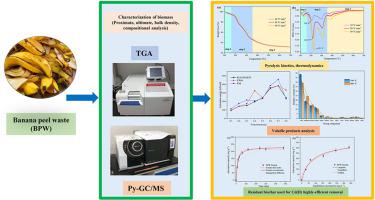当前位置:
X-MOL 学术
›
Biomass Bioenergy
›
论文详情
Our official English website, www.x-mol.net, welcomes your feedback! (Note: you will need to create a separate account there.)
Bioenergy and value-added chemicals of banana peel waste (BPW): Deeper insights from thermal kinetics, thermodynamics, in-situ volatile products analysis, and bio-chars application for Cd(II) highly-efficient removal
Biomass & Bioenergy ( IF 5.8 ) Pub Date : 2024-05-02 , DOI: 10.1016/j.biombioe.2024.107238 Long Chen , Zhi Tu , Yongdong Chen , Jian Hu , Hong Wang
Biomass & Bioenergy ( IF 5.8 ) Pub Date : 2024-05-02 , DOI: 10.1016/j.biombioe.2024.107238 Long Chen , Zhi Tu , Yongdong Chen , Jian Hu , Hong Wang

|
This study presents a comprehensive investigation into the physicochemical properties of banana peel waste (BPW) and its potential for thermochemical conversion into bioenergy and value-added chemicals, supported by the results of kinetics, thermodynamics, in-situ volatile products, and biochar analysis. The physicochemical analysis confirms its potential as a source of renewable fuels and valuable chemicals. Subsequently, based on the TGA outcomes, both kinetic and thermodynamic analysis were conducted. The average activation energy (226–257 kJ mol), high heating value (19.56 MJ kg), Gibbs free energy (118–149 kJ mol), and enthalpy change (222–252 kJ mol) all underscore the substantial potential of BPW for bioenergy production and its compatibility for co-pyrolysis with other waste materials. Moreover, Py-GC/MS analysis reveals that the pyrolysis of BPW primarily yields volatile products such as acids, aldehydes, alcohols and ketones, offering a potential source of value-added chemicals. Furthermore, the residual solid biochar exhibits an impressive maximum adsorption capacity of 360.18 mg g for Cd(II) in aqueous environments, thereby further highlighting the exceptional quality of BPW-derived biochar as a superior adsorbent for heavy metals. In summary, this study holds significant importance in promoting the efficient utilization of BPW and mitigating the environmental pollution resulting from improper disposal.
中文翻译:

香蕉皮废物(BPW)的生物能源和增值化学品:从热动力学、热力学、原位挥发性产物分析和生物炭高效去除Cd(II)的应用中获得更深入的见解
本研究对香蕉皮废物(BPW)的物理化学性质及其热化学转化为生物能源和增值化学品的潜力进行了全面研究,并得到了动力学、热力学、原位挥发性产物和生物炭分析结果的支持。物理化学分析证实了其作为可再生燃料和有价值化学品来源的潜力。随后,根据 TGA 结果进行了动力学和热力学分析。平均活化能 (226–257 kJ mol)、高热值 (19.56 MJ kg)、吉布斯自由能 (118–149 kJ mol) 和焓变 (222–252 kJ mol) 都强调了 BPW 的巨大潜力生物能源生产及其与其他废料共热解的兼容性。此外,Py-GC/MS 分析表明,BPW 的热解主要产生挥发性产物,如酸、醛、醇和酮,为增值化学品提供了潜在的来源。此外,残留的固体生物炭在水环境中对 Cd(II) 表现出令人印象深刻的最大吸附能力 360.18 mg g,从而进一步凸显了 BPW 衍生生物炭作为重金属的优异吸附剂的卓越品质。综上所述,本研究对于促进BPW的高效利用、减轻因处置不当造成的环境污染具有重要意义。
更新日期:2024-05-02
中文翻译:

香蕉皮废物(BPW)的生物能源和增值化学品:从热动力学、热力学、原位挥发性产物分析和生物炭高效去除Cd(II)的应用中获得更深入的见解
本研究对香蕉皮废物(BPW)的物理化学性质及其热化学转化为生物能源和增值化学品的潜力进行了全面研究,并得到了动力学、热力学、原位挥发性产物和生物炭分析结果的支持。物理化学分析证实了其作为可再生燃料和有价值化学品来源的潜力。随后,根据 TGA 结果进行了动力学和热力学分析。平均活化能 (226–257 kJ mol)、高热值 (19.56 MJ kg)、吉布斯自由能 (118–149 kJ mol) 和焓变 (222–252 kJ mol) 都强调了 BPW 的巨大潜力生物能源生产及其与其他废料共热解的兼容性。此外,Py-GC/MS 分析表明,BPW 的热解主要产生挥发性产物,如酸、醛、醇和酮,为增值化学品提供了潜在的来源。此外,残留的固体生物炭在水环境中对 Cd(II) 表现出令人印象深刻的最大吸附能力 360.18 mg g,从而进一步凸显了 BPW 衍生生物炭作为重金属的优异吸附剂的卓越品质。综上所述,本研究对于促进BPW的高效利用、减轻因处置不当造成的环境污染具有重要意义。
















































 京公网安备 11010802027423号
京公网安备 11010802027423号